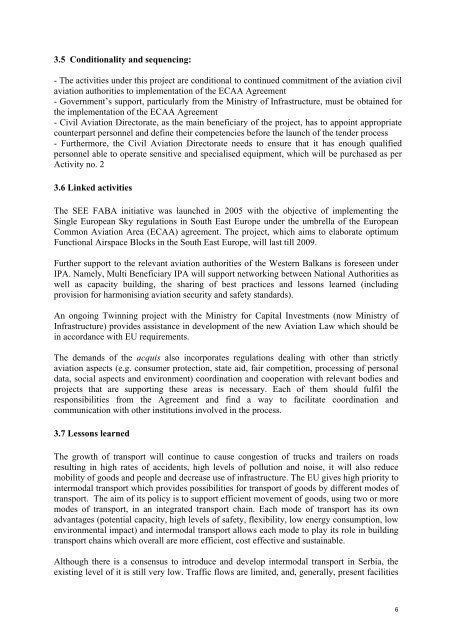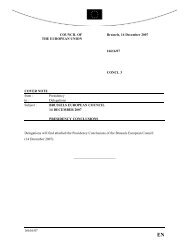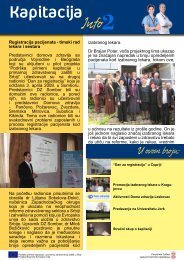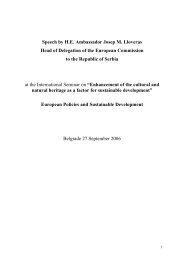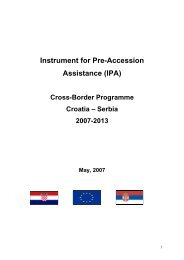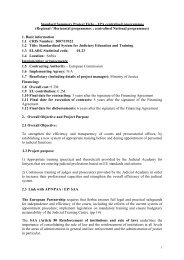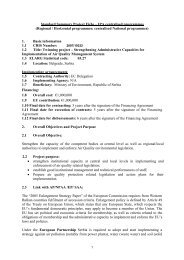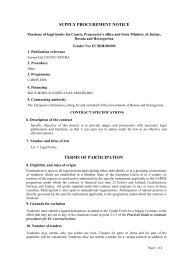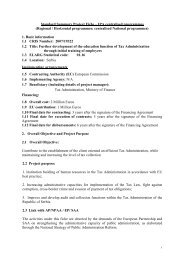Implementation of Common Aviation Area - European Commission
Implementation of Common Aviation Area - European Commission
Implementation of Common Aviation Area - European Commission
Create successful ePaper yourself
Turn your PDF publications into a flip-book with our unique Google optimized e-Paper software.
3.5 Conditionality and sequencing:<br />
- The activities under this project are conditional to continued commitment <strong>of</strong> the aviation civil<br />
aviation authorities to implementation <strong>of</strong> the ECAA Agreement<br />
- Government’s support, particularly from the Ministry <strong>of</strong> Infrastructure, must be obtained for<br />
the implementation <strong>of</strong> the ECAA Agreement<br />
- Civil <strong>Aviation</strong> Directorate, as the main beneficiary <strong>of</strong> the project, has to appoint appropriate<br />
counterpart personnel and define their competencies before the launch <strong>of</strong> the tender process<br />
- Furthermore, the Civil <strong>Aviation</strong> Directorate needs to ensure that it has enough qualified<br />
personnel able to operate sensitive and specialised equipment, which will be purchased as per<br />
Activity no. 2<br />
3.6 Linked activities<br />
The SEE FABA initiative was launched in 2005 with the objective <strong>of</strong> implementing the<br />
Single <strong>European</strong> Sky regulations in South East Europe under the umbrella <strong>of</strong> the <strong>European</strong><br />
<strong>Common</strong> <strong>Aviation</strong> <strong>Area</strong> (ECAA) agreement. The project, which aims to elaborate optimum<br />
Functional Airspace Blocks in the South East Europe, will last till 2009.<br />
Further support to the relevant aviation authorities <strong>of</strong> the Western Balkans is foreseen under<br />
IPA. Namely, Multi Beneficiary IPA will support networking between National Authorities as<br />
well as capacity building, the sharing <strong>of</strong> best practices and lessons learned (including<br />
provision for harmonising aviation security and safety standards).<br />
An ongoing Twinning project with the Ministry for Capital Investments (now Ministry <strong>of</strong><br />
Infrastructure) provides assistance in development <strong>of</strong> the new <strong>Aviation</strong> Law which should be<br />
in accordance with EU requirements.<br />
The demands <strong>of</strong> the acquis also incorporates regulations dealing with other than strictly<br />
aviation aspects (e.g. consumer protection, state aid, fair competition, processing <strong>of</strong> personal<br />
data, social aspects and environment) coordination and cooperation with relevant bodies and<br />
projects that are supporting these areas is necessary. Each <strong>of</strong> them should fulfil the<br />
responsibilities from the Agreement and find a way to facilitate coordination and<br />
communication with other institutions involved in the process.<br />
3.7 Lessons learned<br />
The growth <strong>of</strong> transport will continue to cause congestion <strong>of</strong> trucks and trailers on roads<br />
resulting in high rates <strong>of</strong> accidents, high levels <strong>of</strong> pollution and noise, it will also reduce<br />
mobility <strong>of</strong> goods and people and decrease use <strong>of</strong> infrastructure. The EU gives high priority to<br />
intermodal transport which provides possibilities for transport <strong>of</strong> goods by different modes <strong>of</strong><br />
transport. The aim <strong>of</strong> its policy is to support efficient movement <strong>of</strong> goods, using two or more<br />
modes <strong>of</strong> transport, in an integrated transport chain. Each mode <strong>of</strong> transport has its own<br />
advantages (potential capacity, high levels <strong>of</strong> safety, flexibility, low energy consumption, low<br />
environmental impact) and intermodal transport allows each mode to play its role in building<br />
transport chains which overall are more efficient, cost effective and sustainable.<br />
Although there is a consensus to introduce and develop intermodal transport in Serbia, the<br />
existing level <strong>of</strong> it is still very low. Traffic flows are limited, and, generally, present facilities<br />
6


